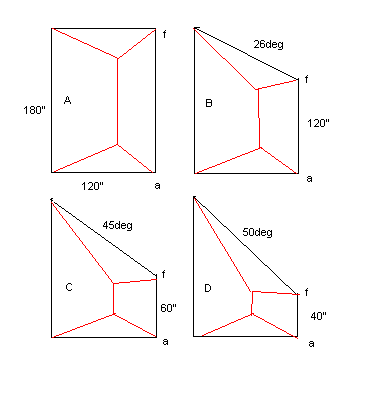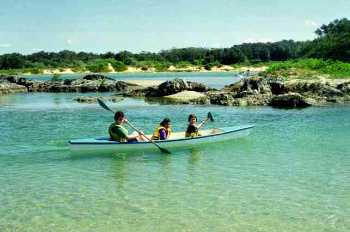
Adam Abrego & Co. try out their new Campjon.
Contents:
Contact info:
Jim Michalak
118 E Randall,
Lebanon, IL 62254Send $1 for info on 20 boats.
Jim Michalak's Boat Designs
118 E Randall, Lebanon, IL 62254
A page of boat designs and essays.
(1jul02) This issue will discuss more sail shaping . The 15jul02 issue will show some action at the 2002 Midwest Messabout.
ON LINE CATALOG OF MY PLANS...
... can now be found at Duckworks Magazine. You order with a shopping cart set up and pay with credit cards or by Paypal. Then Duckworks sends me an email about the order and then I send the plans right from me to you. The prices there are $6 more than ordering directly from me by mail in order to pay Duckworks and credit charges. The on line catalog has more plans offered, about 65, than what I can put in my paper catalog and the descriptions can be more complete and can have color photos.

|
Left:
Adam Abrego & Co. try out their new Campjon.
|
|
|
Sail Shaping 2
BACKGROUND...Remember in the last issue I tried to come up with some "rules of thumb" for the darts used to shape the draft in a three sided sail. Here is the resulting chart:

I would use this chart for triangular sails of normal proportions. It starts with a 48 sq foot sail which is about the smallest sail useful. And progresses to a 147 square foot sail, which is about the largest sail I would try with normal polytarp technology. Somewhere in between should be the "gap" you are looking for. The "gap" refers to the amount of material to be removed from the sail's tack to give it the proper shape. In a polytarp sail that might be removed with a shaping dart that is half the size of the calculated gap.
The gap shown in the chart was calculated assuming a 10% draft, which is sometimes thought to be the optimum. I ran some numbers to figure the effect of draft on the gap. The example used in the numbers had a foot of 10' and a luff of 15'. The chart shows a sail with a 10' foot would need a gap of about 6.4". The same sail with a 5% draft would need a gap of just 1.5" and with a 7.5% draft would need a 3.7" gap. So there is a large effect. Showing that as a chart in percentage, it would look like this:

For example, if you had a sail with a 12' foot and wanted a 7% draft, what would the size of the gap at the tack? The first chart shows the gap needed for 10% draft to be 7.6" for the 12' foot. The second chart shows that for 7% draft the gap would be 50% of that, for a tack gap of 3.8" which would mean a shaping dart 1.9" wide.
NEXT...
You may remember that when I did the calculations for the first chart that I put the point of maximum draft 1/3rd of the way aft from the luff and 1/3rd of the way up from the foot. What if the point of maximum draft were lower? I ran an example using the 10' x 15' triangular sail where I lowered the point of maximum draft from 60" up from the foot to just 20". The effect was to increase the tack gap size a tiny amount from 6.4" to 6.8". So I don't think that is really a factor.
FOUR SIDED SAILS...
Next I looked at the darts needed to shape a four sided sail like a lug sail or a gaff sail. I have been using two darts in these sails, one radiating out from the tack and another from the throat. Here is a photo of Jeff Blunk's prototype Frolic2, now owned by Richard Harris in Illinois. The photo was taken at Rend Lake a few weeks ago and you can clearly see the two shaping darts.

From figuring the shape of lug sails in the past I had the opinion that the peaking of the yard has the effect of reducing the size of the dart needed at the throat. In fact I suppose the extreme case would be a Solent lug where the yard is peaked all the way up as an extension of the mast - a triangular sail needing only one shaping dart. I looked at four sided sails that look like this:

So the overall size was the same as the triangular sails, 120" foot and 180" height.
All of these sails needed a gap at the tack of about 5.5" compared to about 6.5" for the triangular sail, 85% of the triangular sail. So the peak angle really has no affect on the tack dart.
The throat dart changes with the angle of the peak. Sail A needs 5.5" gap at the peak dart. Sail B needs 5" gap at the peak dart. Sail C needs 2.6" gap at the peak dart, and sail D needs 3.4" gap at the peak dart.
Plotting it out looks like this:

I expected a smooth curve! But no, there is a bump. I double checked my numbers and it was still there. If there is an error in there I think it is in the 50 degree example. I would expect that sail would need a gap of about 2" instead of 3.4".
Let's think of a real life example. Let's try the large Piccup pram sail which has a foot of 105", and a peak angle of about 45 degrees. Let's assume 10% draft.
Let's figure the tack gap first. If you look at the triangular sail data for 8.75 ft foot, the gap for the triangular sail would be about 5.7". If we use an 85% factor to adjust that to a four sided sail then I would expect the tack gap for the large Piccup sail to be about 4.8".
Now for the throat gap. Looking at the above chart I would expect it to be about 50% of the tack gap, or 2.4".
Back in the 15oct98 issue I figured the large Piccup sail out the long way. The results then were a tack gap of 5.2" and a throat gap of 1". So the tack gap using the above system compares quite well with the complex calculations I did back then. The throat gap is off by a ways, isn't it? I noticed on the Piccup article that I used a flatter draft in the top of the sail then which might account for some of it. I can't explain the rest other than to say the gross approximations I used above give reasonable answers and will give very reasonable sails.
Here is a photo of Rob Rhode-Szudy's Piccup at the Rend Lake messabout with his Piccup with a large polytarp sail made with the twin dart method. It sailed quite well indeed!

NEXT TIME...
We'll look at the 2002 Midwest Messabout at Rend Lake.
Contents
PIRAGUA

PIRAGUA, SWAMPBOAT, 13' X 30", 70 POUNDS EMPTY
The photo above is of a Piragua built by Bob Taylor down in Texas. Piragua is a very simple useful boat. I probably get more Piragua photos than of any other boat, an indication that more Piraguas get built. Piragua is made from two sheets of 1/4" plywood with very simple old fashioned glue and nail construction. It's very suitable as a first project, both as a way to learn construction and as a boat you will use a lot. But the first Piragua almost never got built, an indication that you can't tell what will be popular in this hobby. I drew it up an thought it pretty good for what it was supposed to be. I put it in my prototypes catalog and had two blueprint sets printed. After a year in the catalog I still had those two prints! I took it out of the catalog. About a month later I sold one set to Don O'Hearn and gave the other set away to Brian Waters who had ordered other plans, saying he was looking for a project for his sixth grade shop class.
Both boats got built! Waters' bunch of kids finished the first one, shown below. Brian also sent an article from his local newspaper showing the boat with himself and a class full of smiling kids behind the boat. I still have the copy on my wall and always thought it to be a trophy!

O'Hearn's boat followed very closely and he lives close enough that he brought the boat to our Messabout and I had a chance to try it myself. I thought it was quite good. I could just barely stand up in it, very common of this sort of narrow boat. It's 24" wide on the bottom and I've found that you can't reliably stand up in something that narrow. Don used the boat for fishing in little waters and keeps his butt on the seat. You paddle Piragua with a double paddle like a kayak. Here is Don's boat with his son at the paddle.

Here is another boat local to me by Rich and Ben Scobbie of St. Jacob, Illinois.

Steve Jacob built this one with Spanish moss hanging above. His used taped seams instead of the external chine logs with some crown to the decks.

And here is a photo from New South Wales from Ashley Cook. I'm very glad these boats are getting around. You can see these are best as solo boats but have the room and capacity to take some passengers in good conditions. Also you can tell that kids really take well to this sort of boat. They are easily understood in one glance. Still, you have to take any boat seriously. If you fall out of or capsize a boat like this you well need special training and gear to get going again in deep water. If built with the end air boxes the boat will have plenty of buoyancy but probably won't be stable enough for you to get back in. I think the only way to do the job is with a bailing scoop and a way to lash the paddle across the boat with a flotation cushion attached to one end to stabilize the boat in roll. You have to do all this as you swim around. My own appoach is to use these close to shore in warm water!

Plans for Piragua are still $15.
Prototype News
Some of you may know that in addition to the one buck catalog which now contains 20 "done" boats, I offer another catalog of 20 unbuilt prototypes. The buck catalog has on its last page a list and brief description of the boats currently in the Catalog of Prototypes. That catalog also contains some articles that I wrote for Messing About In Boats and Boatbuilder magazines. The Catalog of Prototypes costs $3. The both together amount to 50 pages for $4, an offer you may have seen in Woodenboat ads. Payment must be in US funds. The banks here won't accept anything else. (I've got a little stash of foreign currency that I can admire but not spend.) I'm way too small for credit cards.
Here are the prototypes abuilding that I know of:
Electron: The California Electron looks done to me. Right now a four cycle 2 hp outboard has been purchased so the original electric idea may wait a while.

Shanteuse: The stretched (16' to 24') Shanteuse is about done. I'm told it has been water tested.

Sowsear: Just heard of a prototype Sowsear going together very quickly in Pennsylvania.
AN INDEX OF PAST ISSUES
Hullforms Download (archived copy)
Plyboats Demo Download (archived copy)
Brokeboats (archived copy)
Brian builds Roar2 (archived copy)
Herb builds RB42 (archived copy)